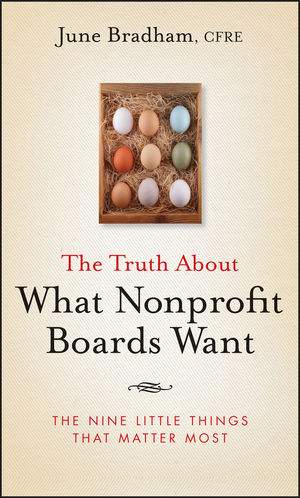The Truth About What Nonprofit Boards Want: The Nine Little Things That Matter MostISBN: 978-0-470-45800-6
Hardcover
141 pages
June 2009
 This is a Print-on-Demand title. It will be printed specifically to fill your order. Please allow an additional 10-15 days delivery time. The book is not returnable.
|
||||||
Introduction.
Myth 1 It’s the Cause, Not the Company.
The Truth Current board makeup is the number one reason a top-flight candidate will agree to consider board service—or will not.
Myth 2 A Great Board Member Is a Great Board Member. Period.
The Truth The board member who doesn’t feel the cause passionately from head to toe can’t compete with one who does.
Myth 3 The Board Alone Is Responsible for Success or Failure.
The Truth Without a dedicated, smart, visible, and vocal CEO at the helm, a board will not totally engage.
Myth 4 CEO and Board Members Are Colleagues. Nothing More.
The Truth Engaged boards have an inspired CEO who forms a partnership with board members and demonstrates a passion for the mission while keeping ego in check.
Myth 5 It’s About the Work, Not About the Party.
The Truth “All work and no play” makes Jack an unhappy board member.
Myth 6 What the Executive Committee Shares Is Its Business.
The Truth The board chair and the CEO must build trust with the entire board.
Myth 7 Great Board Members = Big Check Writers. That’s All.
The Truth Board giving is directly correlated to the board experience.
Myth 8 No One Cares About Gift Expectations Two Years Out.
The Truth Tell the board in advance what is expected—all of it.
Myth 9 Boards Get a Lot from Training.
The Truth Board members hate anything labeled training.
The Other Side of the Story.
Jon Dellandrea, PhD, Former Pro Vice Chancellor, The University of Oxford.
Young P. Dawkins, III, Vice Principal for Advancement, University of Edinburgh.
Charles Phlegar, Vice President, Alumni Affairs and Development, Cornell University.
Nigel Redden, Director, Spoleto Festival USA.
Conclusion.
Appendix: AlignMint.
A Self-Assessment Tool for Boards and Leadership.
Stage 1: Discovery.
Stage 2: Building the Relationship.
Stage 3: Full Commitment.
About the Author.
Index.



